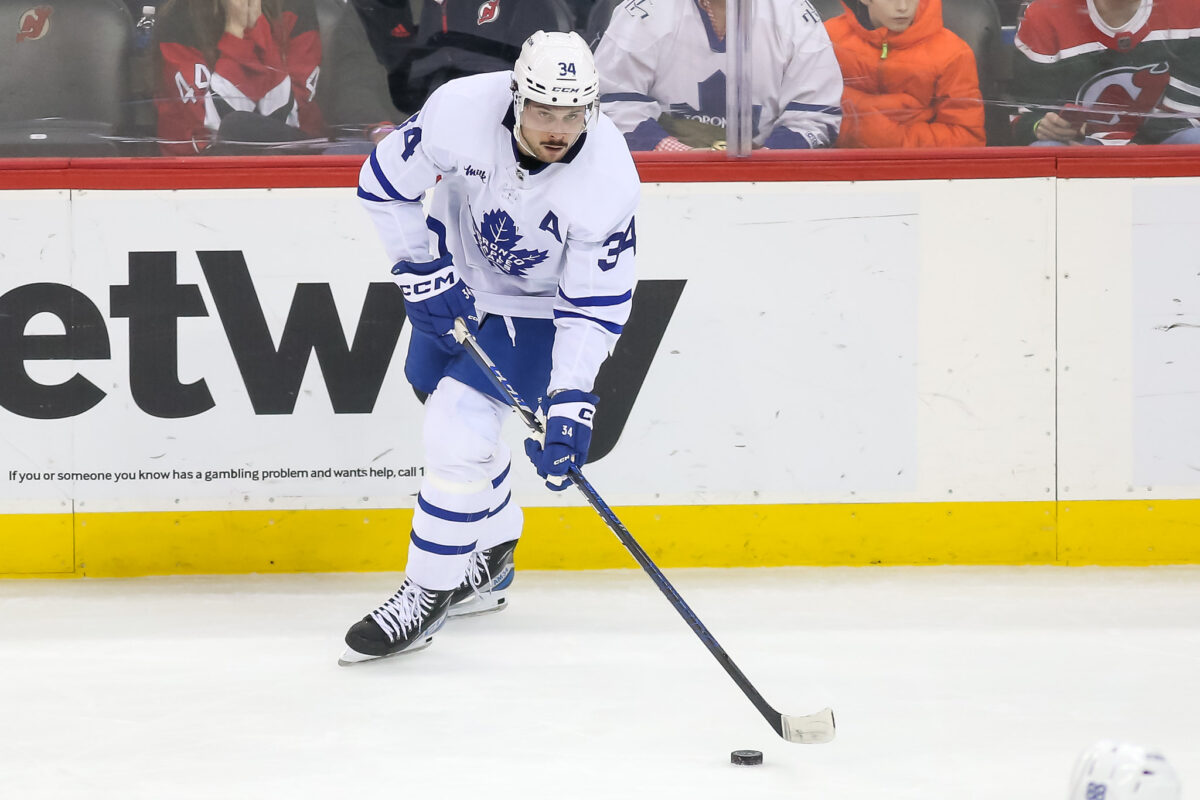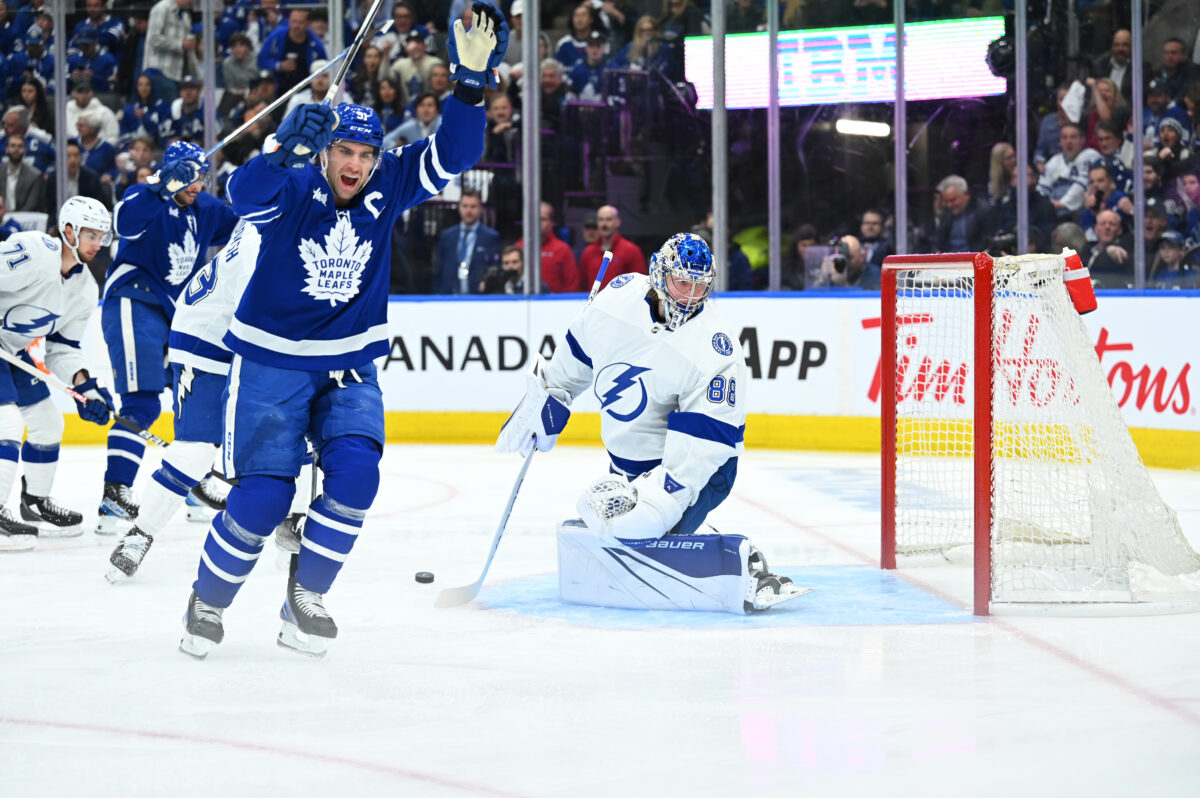It just wouldn’t seem like a new NHL season if we didn’t bring up an old debate. Would the Toronto Maple Leafs be better off with Auston Matthews lining up with Mitch Marner, or should Matthews center a line with William Nylander on the wing and John Tavares play with Marner?
Related: Chloe Primerano Developing Into Team Canada’s Next Star
The chemistry between Matthews and Marner is well-documented and their styles complement each other. Matthews is one of the best goal-scorers in the league, if not the best, and Marner is one of the best playmakers. Together, they are one of the best center/winger combinations in Maple Leafs history and one of the best active combinations in the NHL.
There Are a Few Issues with the Matthews & Marner Partnership
However, playing Matthews and Marner together puts the Maple Leafs’ two best eggs in one basket. It also makes Tavares and Nylander the foundation of the second line. While these two have had some success together and have put up points at a good pace, defensively, they tend to give up as many goals as they score.
Using old-school plus/minus as a metric, Tavares is minus-15 over the past two seasons, while Nylander is plus-1. To compare, Matthews is plus-51 over that same period, and Marner is plus-41.
Under Coach Mike Babcock, Matthews and Marner Were Separated
When the foursome of Matthews, Marner, Tavares, and Nylander first played together, it was under the purview of then-head coach Mike Babcock. Babcock insisted on playing Matthews with Nylander and Marner with Tavares. However, there was a short string of games where Matthews was on a bit of a cold spell, and Babcock played him with Marner.
Related: Every NHL Team’s All-Time Leader in Points
Still, that experiment was extremely short-lived. Once Matthews got rolling again, they were split up. Also of note, Tavares had his best goal-scoring season when Marner was his winger, potting 47 goals during the 2018-19 season.
When Sheldon Keefe took over the reins behind the bench, he put Matthews and Marner together. Although he has played them apart more than Babcock had them together, most of their ice time has been spent together.
Hockey Is a Team Game, Individual Statistics Come Second
Hockey is a team game. Individual statistics are wonderful, and the best players put up massive numbers. However, what counts the most is which team scores the most goals. While a player having a four or five-goal game looks good on the scoresheet, if that player were also on the ice when the opposing team scored more goals, the result would be a loss, and those goals would be wasted.

Also, how a player performs on the power play or the penalty kill is important, but how they perform at five-on-five is more so, especially in terms of player combinations and how they perform together.
What Do the Numbers Tell Us About Five-on-Five Play?
With that in mind, we decided to look at how the different combinations have faired in goals for and against at five-on-five over the past two seasons.
Related: Remembering Maple Leafs’ Goalie Jonathan Bernier
The combination that has spent the most time together at five-on-five is Matthews and Marner. They have played a total of 1,285 minutes together, and in that time, the Maple Leafs scored 99 goals and allowed 59 against. That means, for every 60 minutes, Matthews and Marner averaged 4.62 goals for and 2.75 against. That’s a plus 1.87 goals for per 60 minutes.
Over the same two seasons, Tavares and Nylander played 1,057 minutes together and were on the ice for 53 goals for and 66 against. Per 60 minutes, the Maple Leafs gave up an average of 3.75 goals while scoring just 3.00 when they were on the cie. That’s a minus 0.75 goals for per 60 minutes.

(Photo by Gavin Napier/Icon Sportswire via Getty Images)
During the last two seasons, Marner has played 815 minutes at five-on-five with Tavares, scoring 42 goals for an average 3.09 goals for per 60 minutes. They gave up 31 goals for an average 2.28 goals against per 60. The difference is plus 0.81 goals for per 60.
Matthews and Nylander spent 756 minutes together at five-on-five. During that time, the team scored 47 goals, for a 3.73 goals per 60, and gave up 30 goals, for an average 2.38 goals against per 60. That is a plus 1.35 goals for per 60.
If we combine the Matthews/Marner plus 1.87 and the Tavares/Nylander minus 0.75 we get an overall positive 1.12 goals for per 60.
Related: Ex-Maple Leafs Goalie Michael Hutchinson: Where’s He Now?
If we compare that to the Matthews/Nylander plus 1.35 and the Tavares/Marner plus 0.81, we get an overall positive 2.16 goals for per 60 minutes. That combines for an extra goal per 60 minutes.
Other Factors Are Involved in a Maple Leafs Final Decision
We understand there are other factors at play here. At five-on-five, there are three other skaters on the ice, another forward, and two defensemen. These statistics also do not take into consideration the goaltenders and how they played.

Still, the goals for and against stats we used were over two seasons and 164 total games played. They do mean something. While these four players might not have had all of the influence in what was happening on the ice, they would have had the most influence.
How Will Bertuzzi, Domi & Knies Impact Each Line’s Success?
Looking ahead, we can’t know what influence the new acquisitions will have on the lineup. Tyler Bertuzzi, Max Domi, and Matthews Knies will impact the play of the team’s top four forwards.
However, the numbers are pretty persuasive. Using goals for and against at five-on-five as a guide, it would suggest that the Maple Leafs would be better off at least trying Matthews with Nylander and Marner with Tavares for a more extended period. In short, we believe it’s time to separate Matthews and Marner.
[Note: I want to thank long-time Maple Leafs’ fan Stan Smith for collaborating with me on this post. Stan’s Facebook profile can be found here.]
